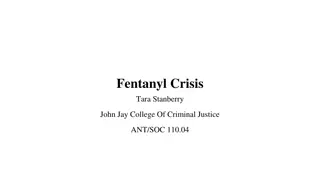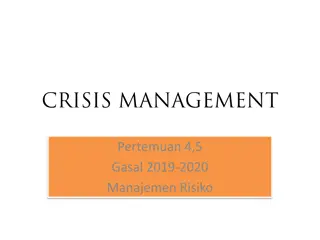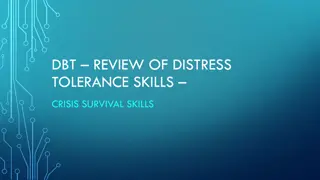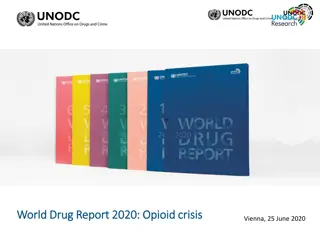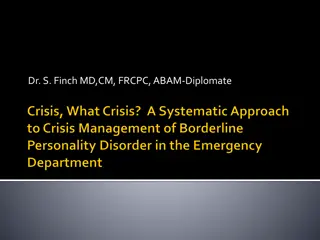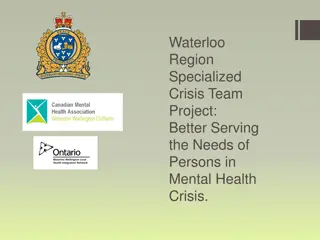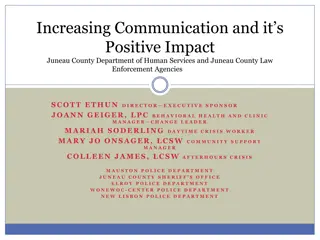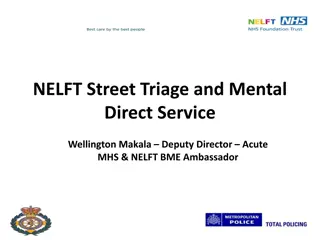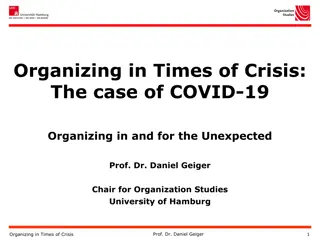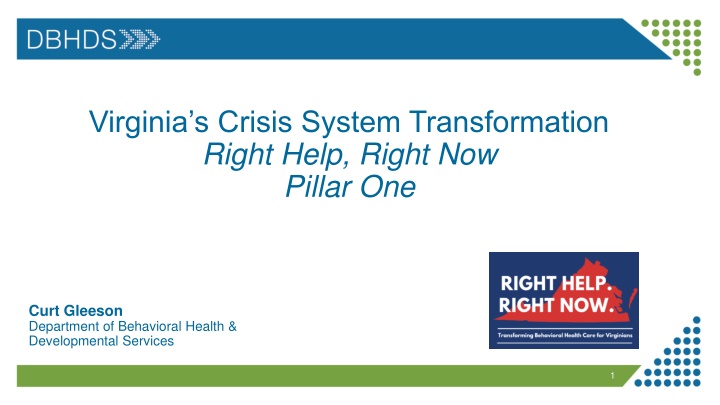
Crisis System Transformation in Virginia
The Crisis System Transformation in Virginia aims to provide vital crisis services to individuals in need through elements like regional crisis call centers, mobile crisis teams, and crisis receiving and stabilization facilities. These services are designed to offer immediate support to anyone, anywhere, and at any time by creating a comprehensive system of care that ensures seamless transitions for individuals in crisis.
Download Presentation

Please find below an Image/Link to download the presentation.
The content on the website is provided AS IS for your information and personal use only. It may not be sold, licensed, or shared on other websites without obtaining consent from the author. If you encounter any issues during the download, it is possible that the publisher has removed the file from their server.
You are allowed to download the files provided on this website for personal or commercial use, subject to the condition that they are used lawfully. All files are the property of their respective owners.
The content on the website is provided AS IS for your information and personal use only. It may not be sold, licensed, or shared on other websites without obtaining consent from the author.
E N D
Presentation Transcript
Virginias Crisis System Transformation Right Help, Right Now Pillar One Curt Gleeson Department of Behavioral Health & Developmental Services 1
2020 SAMHSA Best Practice Toolkit Introduction, Page 8 We must start by defining what crisis services are and what they are not. Crisis services are for anyone, anywhere and anytime. Examples of crisis level safety net services seen in communities around the country include (1) 911 accepting all calls and dispatching support based on the assessed need of the caller, (2) law enforcement, fire or ambulance personnel dispatched to wherever the need is in the community and (3) hospital emergency departments serving everyone that comes through their doors from all referral sources. These services are for anyone, anywhere and anytime. Similarly, crisis services include (1) crisis lines accepting all calls and dispatching support based on the assessed need of the caller, (2) mobile crisis teams dispatched to wherever the need is in the community (not hospital emergency departments) and (3) crisis receiving and stabilization facilities that serve everyone that comes through their doors from all referral sources. These services are for anyone, anywhere and anytime. 2
2020 SAMHSA Best Practice Toolkit The following represent the National Guidelines for Crisis Care essential elements within a no- wrong-door integrated crisis system: Core Services and Best Practices, Page 12 1.Regional Crisis Call Center: Regional 24/7 clinically staffed hub/crisis call center that provides crisis intervention capabilities (telephonic, text and chat). Such a service should meet National Suicide Prevention Lifeline (NSPL) standards for risk assessment and engagement of individuals at imminent risk of suicide and offer air traffic control (ATC) - quality coordination of crisis care in real-time; 2.Crisis Mobile Team Response: Mobile crisis teams available to reach any person in the service area in his or her home, workplace, or any other community-based location of the individual in crisis in a timely manner; and 3.Crisis Receiving and Stabilization Facilities: Crisis stabilization facilities providing short-term (under 24 hours) observation and crisis stabilization services to all referrals in a home-like, non-hospital environment. Although there are many other services that will be incorporated into the continuum of a comprehensive system of care, these three programmatic components represent the three true crisis service elements when delivered to the fidelity of the Crisis Service Best Practice guidelines defined in this toolkit. However, crisis systems must not operate in isolation; instead striving to fully incorporate within the broader system of care so seamless transitions evolve to connect people in crisis to care based on the assessed need of the individual. 3
Someone to Call Someone to Respond Somewhere to Go CrisisStabilizationSites CrisisCallCenters MobileCrisis Mobile Crisis Response teamsare deployed in real-time, 24 hoursa day, to the location of the individual experiencing a behavioral health crisis.Theserapid responders provide on- scene evaluation, intervention, and connection to follow-up resources. 23-hour Crisis Receiving Centers and short-term residential Crisis Stabilization Units provide a safe, secure community-based environment for assessment,resources, and emergent crisis treatment. When someone calls 988, a trained crisisworker will provide support such as safety planning, referrals, and alistening ear.If needed, crisis workers can connect to the full continuum of services. Through Virginia sco-responder initiative (Marcus Alert) appropriate calls to 911can be routed to the 988 call centers. 4
Outofthosenine,onemay require services at a higher level of care,likea hospital, while the other eight return safely to the community. Mobile crisis response can be dispatched for the remaining 20. Ofthose20,ninemay need further treatment at a Crisis Stabilization Site. If 100people call 988, 80 of those calls can be resolved over the phone. 5
Individuals in crisis should be matched with the appropriate level of care to meet their needs safely and effectively at that time. Risk Level Low Moderate High Zone of High Variability CallCenters CrisisStabilization Sites MobileCrisis PeerWarmLines Crisis Intervention Peer Recovery Centers BehavioralHealth&Law EnforcementCo- Response CPEP Community Based Stabilization State Hospitals Grief&OtherSupportGroups Continuum AcutePsychiatric Inpatient Community Services Boards Same Day Access Transportation Referrals Partial Hospitalization Programs Medically Managed Detox 6
Someone to Call Someone to Respond Somewhere to Go CrisisCallCenters MobileCrisis CrisisStabilizationSites Nearly 13,000 calls last month to 988. Additional calls to Veteran, LGBTQ+, and local crisis lines answered by call centers. Geo-routing likely to launch nationally this fall. Total dispatches since 12/15/2023 Average response time Average duration Dispatches by each region Any utilization data for CRCs and CSUs? Any data on number of TDO admissions? 7

